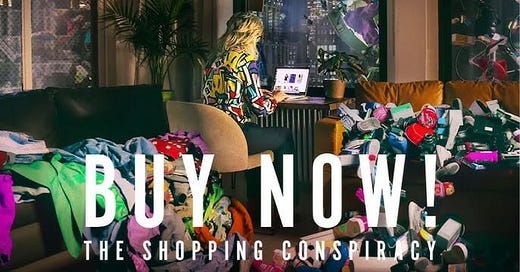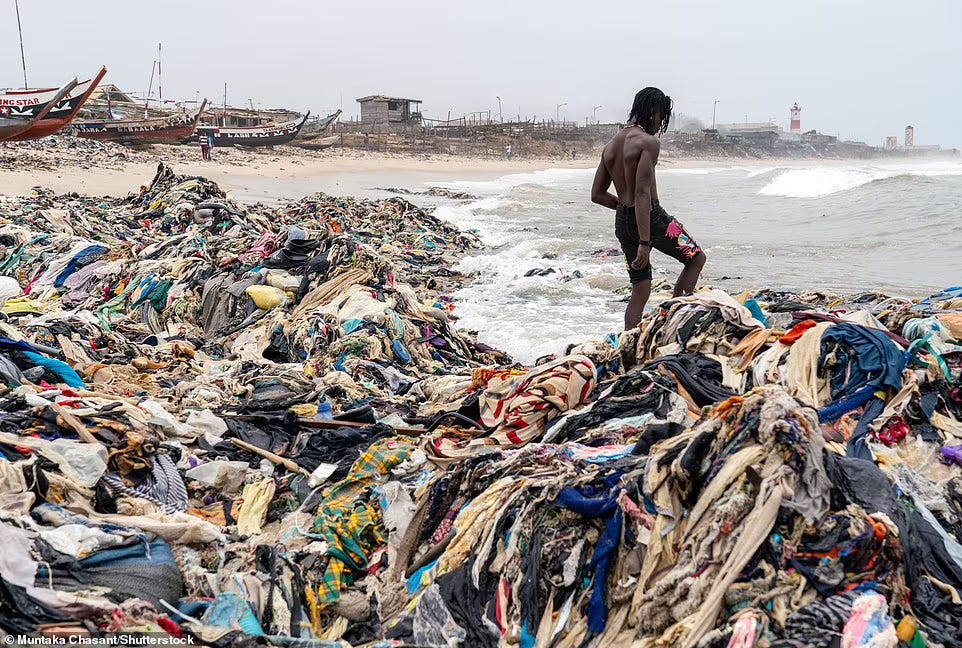Has that Netflix documentary made you feel a bit sick? If you haven't seen Buy Now! The Shopping Conspiracy yet, then it is a riveting and nauseating dive into the venal methodologies businesses are using to manipulate you into buying stuff you don’t need, at every available opportunity.
Tracing the history of shopping back to a moment when as a society we switched from a ‘needs’ to a ‘wants’ model, shows how we have shifted from a balanced, sustainable society, into one that is drowning in stuff that never fully satisfies us, duped into addiction behaviours that force us to acquire more and more. It is nauseating stuff, and if you are looking for a panacea for today’s Black Friday rush, settling down in front of this documentary is the answer.
Rule of 5 is a free resource for those looking for ways to cut their shopping habits. You can show your commitment by subscribing. No special Black Friday deals I’m afraid, just good old fair pricing for a fair product.
There are some interesting historic threads to dig into here (not all in the documentary). Some believe prohibition in America triggered the change, as business spotted people needed a replacement hedonistic release in the absence of alcohol, (a chap called Samuel Strauss wrote an essay about what he identified as ‘consumptionism” in 1924, according to The Enoughness). World Wars 1 and 2 showed how factories could be geared up to produce mass supplies, places like Ford motor factories started to build munitions, and the potential of the production line kicked in. Edward Bernays, the nephew of Sigmund Freud, was also a foundational figure - using his uncle's psychological analysis he identified that we are all driven by our insecurities and could employ that to drive business. So he sold cigarettes to women as symbols of empowerment, and convinced America that only disposable cups were sanitary - he was the godfather of what we now call PR, even writing a book about it in 1929 which he titled ‘Propaganda’. By the 1960s consumerism was in full swing. Companies like Listerine (which back then made floor bleach), launched an ad campaign to convince housewives their friends were complaining behind their backs that their breath was bad. Advertising was inventing problems for people so they would spend on the solutions.
Then came Jeff Bezos. Could he persuade people to use the newly born internet for shopping? He started with books and music - and, well, you know where it went. The documentary features whistle blowers from Amazon who built the ‘one click’ product, designed to allow you to shop anywhere, anytime, anyhow in the most frictionless way possible. The film is filled with terrifying videos from shoppers who have 'hauled' on Prime overnight and flooded their doorstep with a mountain of boxes the next day. We've all done it to some extent - the Sunday night glass of wine and a quick cruise on Net a Porter… and, oops.
It's consumer electronics and fashion that come off the worst in this documentary. Consumer electronics because of planned obsolescence - products that are specifically designed to stop functioning within a few years so you have to buy new ones. Apple ear buds are the worst apparently - deliberately designed to time out after 18 months with no possible way to replace the battery. Just imagine how many of these little plastic worms there are in the world right now. And how many more are coming.
And of course - fashion. Fashion has planned obsolescence built into its system. Trends that come and go with alarming frequency. Newness drops that operate on our insecurities, driving women to keep up and stay relevant and feel good, by buying something new to wear. Over 60% of this clothing is made from plastic - polyester - and of course we see it now piling up in landfills, lakes and rivers, choking us and burying us. This is brought to life in the film with AI generated montages, but it’s frightening because we know it's also real. The clothes may not be heaped up on our nice Global North side walks yet, but they are in Ghana, Nairobi, Uganda, and Mumbai.
We are trapped in an insidious, vicious cycle of over consumption. As the documentary has it, business is just programmed to ‘sell more, waste more control more.’ Absurd excess has become our new normal and we have become so far removed from the beginning and end life of our clothes that we don’t even see it - instead we congratulate and admire each other for keeping up with the styles. For wearing something new, for rocking a new season or full look. For wearing a different outfit every day.
When I launched this Rule of 5 campaign I did it for climate reasons, to try and curb the waste we are creating. But so many of you who joined the campaign expressed your reasons as being sick of over consumption. Society is making us ill, by stuffing us with things we don’t need. But we do have a choice. We just need to be smart, learn to spot when we are being manipulated, and return to the simple pleasure of shopping for something we genuinely need.
Happy no shopping Friday. Have you managed to resist?!
You can read more on my other Substack It’s Not Sustainable, meanwhile if you fancy pledging to only buy 5 items in the next year, please dig into the archive, or tell me what you need in the comments.







I just want the day off after Thanksgiving and not waste energy, or money/resources, shopping. I need the rest! I have 364 other days of the year to shop, that's plenty to get what I need. And there's always another sale coming, so I don't worry about getting a good deal.
Very timely. I'd just deleted three tempting offers in my inbox, but with a very slight sense of deprivation. Crazy, as I have more than enough clothes (still haven't counted!) We need to keep the higher goal in mind. I will watch that documentary. Thank you.